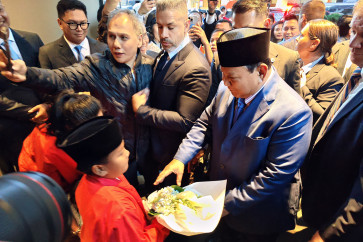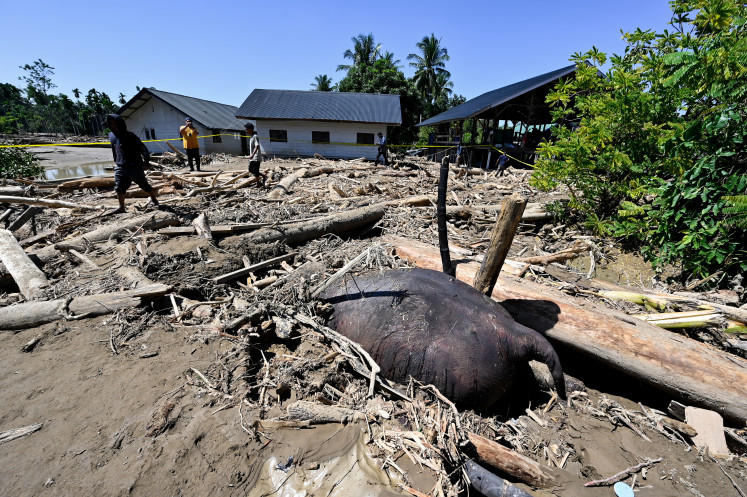Popular Reads
Top Results
Can't find what you're looking for?
View all search resultsPopular Reads
Top Results
Can't find what you're looking for?
View all search resultsDancing at the Mangkunegara
Young voices: Children from Soeryo Soemirat perform Beksan Panembromo in the hall of the Mangkunegara Palace in Surakarta
Change text size
Gift Premium Articles
to Anyone
Y
span class="caption" style="width: 468px;">Young voices: Children from Soeryo Soemirat perform Beksan Panembromo in the hall of the Mangkunegara Palace in Surakarta.The gamelan in a corner of the palace hall was playing softly, faintly sounding a melody in a slow rhythm.
From the back of the hall, nine women entered the performance arena all in a row as the fragrance of incense permeated the air.
Then the dancers dispersed, their graceful movements typical of Javanese classical dance, this time presenting a choreographic collection of the Mangkunegara Palace called Golek Montro to open the 2012 Mangkunegara Performing Arts exhibition in Surakarta recently.
Golek Montro was created by Kanjeng Gusti Pangeran Adipati Aryo (KGPAA) Mangkunegoro VII (1885-1944). The dance of almost 30 minutes duration portrays palace girls who are coming of age and paying attention to their makeup and grooming before welcoming noble guests.
With all their grace at a slow pace, the dancers continued to offer smiling faces, thus attracting the audience that packed the palace hall. Interestingly, one of the Golek Montro performers was Japanese.
Kaori Okado from Nagoya, Japan, has for years been learning Javanese classical dance in Yogyakarta and Surakarta. She has also mastered Banyumas and Bali dancing styles. Of the Mangkunegara collection, Kaori is adept at 15 works.
The next and more vigorous dance was Wireng Bandabaya, presented by four men with firm and valiant movements depicting the skill and courage of Mangkunegara soldiers and clad in uniforms complete with swords and shields.
Choreographed by KGPAA Mangkunegara IV, this dance combines the techniques of Surakarta and Yogyakarta in a blend of dancing and martial arts to represent the bravery of the Mangkunegara army.
The first day of the show also featured the sacred Gambyong Retno Kusumo composed by Mangkunegara VIII. The dance involves intricate motions by using all the Javanese classical techniques to produce harmonious and enchanting hand waves, foot steps, neck turns and facial expressions.
The first day of the show concluded with Beksan Srikandi Larasati, a dance about Srikandi’s jealousy of Larasati, the woman who was engaged to marry Srikandi’s husband, Arjuna. The two women engage in a duel that Srikandi eventually wins, but despite her victory, Srikandi does allow Larasati to become Arjuna’s wife.
According to Gusti Pangeran Haryo Herwasto Kusumo the chair of the event organizers, most of the classical dances in the program were still in their original forms and rarely performed in public.
“Some of the 10 creations appearing in the two-day show have indeed been modified into folk dances such as Wireng Bandabayan and Golek Montro,” said Heru, who is a relative of the Mangkunegaran family.
Gentle: The Beksan Puspito Retno, a dance composed by KGPAA Mangkunegoro IV, is performed in Surakarta.On the second day of the show, the evening program started with Beksan Panembromo with 150 child dancers aged 4 to 10 from the Soeryo Soemirat Dance Studio.
Beksan Jaranan, an energetic and captivating horse dance, followed. Rooted in children’s games,
the dance was performed by about 15 youngsters in an expressive and joyful manner.
Beksan Puspito Retno at the end of the event stunned the large audience. Eight women danced with elegance and harmony in a rhythmic fashion, gently swaying and pushing aside their stoles. After facing each other, they separated into groups and again formed a line.
Apparently playing the same role in the beginning, the eight divided into two opposing groups as the dance neared its end. The mesmerizing choreography was arranged by Mangkunegoro IV. “Mangkunegaran compositions uniquely contain Yogyakarta and Surakarta elements of dance,” said Javanese classical dancer Irawati Kusumorasri.
Karna Tanding was no less appealing. Mostly found in wayang orang (Hindu epic-based dance drama), the dance is about a battle between two brothers, Adipati Karna and Arjuna, in the Bharatayudha (war of the Bharata dynasty). But the Mangkunegaran version shows no emotions of hatred and rage.
On the other hand, Karna and Arjuna appeared mild and gentle even as they were fighting, with jasmine flowers being strewn from their kris to build an atmosphere of civil war. Beksan Wiropratomo, the battle between Gatotkaca, Antasena, Abimanyu and Kurawa in the same war, closed the second day.
In combat: Two male dancers perform Karna Tanding, a duel between prince brothers.Senior Solo dancer Suprapto Soeryodharmo said the dance performances meant to open up Mangkunegara Palace to the public while at the same time introducing and preserving Javanese art and culture. As in previous years, the fourth event remained packed with hundreds of spectators. Apart from members of Soeryo Soemirat, dancers also came from the palace’s Langenprojo (court dance center) and the Mangkunegara Art Academy (ASGA).
The Mangkunegara choreographic collection’s classical nature is rooted in palace traditions. At the Javanese classical level, all body parts from the hands, feet and neck to the head move as stipulated by palace criteria, in which certain motions have their own philosophical values.
Likewise, all dance instruments, outfits and music have their rules.
“Through this event, we wish to invite the public to join the preservation and development of the palace’s cultural treasure, especially classical dances, which form part of the nation’s history of arts too worthy to be lost without proper care,” Heru said.












